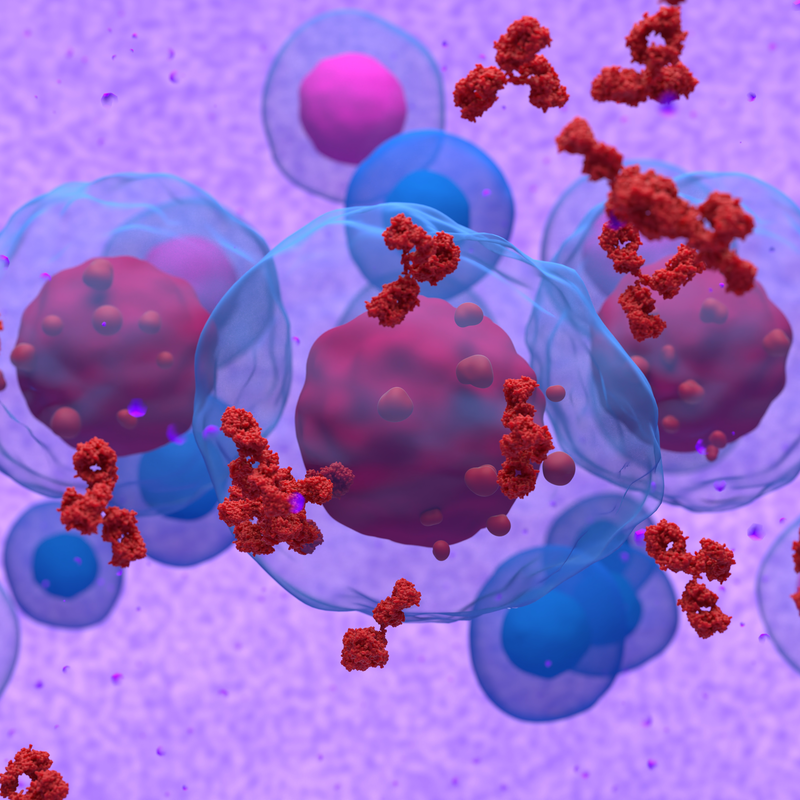
What is multiple myeloma?
Multiple myeloma (MM) is a malignant disease of the bone marrow. The tumour cells grow in a focihaped manner, i.e. in many places in the bone marrow. If there is only one focus of the disease, it is called a solitary plasmocytoma instead . The clinical picture of multiple myeloma is formally classified as lymphoma, although lymph gland involvement is rarely detected. The disease accounts for about 1 percent of all malignant cancers and therefore occurs rather rarely. Multiple myeloma usually develops in patients around the age of 71.
How does multiple myeloma develop?
Like other cancers, multiple myeloma develops through the degeneration of a cell. When multiple myeloma develops , it is the so-called plasma cell. This belongs to the white blood cells, which are found in the bone marrow, but also in other body tissues. White blood cells produce antibodies and are also called immunoglobulins. They are essential for the human immune system as they play a crucial role in fighting off bacteria, viruses and other infectious agents .
What causes multiple myeloma?
The exact causes of multiple myeloma are still unclear. However, contact with highly ionising radiation (radioactivity), a congenital immune deficiency and/or certain autoimmune diseases can significantly increase the risk of developing the disease . In rather rare cases, the disease can also accumulate within the family. Despite this fact, multiple myeloma is not a hereditary disease.
Just as doctors do not yet know the cause of the disease, doctors also do not know of any known risks that could lead to multiple myeloma. Therefore, no preventive measures can be taken .
What are the symptoms of multiple myeloma?
It is possible for multiple myeloma to exist for several years without symptoms . Often, the first symptoms only appear at an advanced stage and then become noticeable mainly through bone pain, mainly in the back. Since in most cases this pain is not associated with multiple myeloma in , weeks or even months can pass between the first symptoms and diagnosis.
The disease is usually only diagnosed when the following additional symptoms appear:
- Signs of anaemia, which can manifest itself as fatigue, lack of drive, headaches or shortness of breath during (minor) exertion,
- Susceptibility to infections and frequent, recurring infections,
- Impaired kidney function, which can be manifested by weight gain due to fluid retention in the body tissues (oedema) ,
- Increased calcium in the blood (hypercalcaemia)
How is multiple myeloma diagnosed?
In some patients, the disease may be diagnosed by chance. This can happen, for example, during a routine blood test that reveals abnormal laboratory values. If, on the other hand, there is a suspicion of multiple myeloma due to symptoms, the attending doctor will carry out a physical examination and then request laboratory values from the patient's blood and urine . If these values are abnormal, diagnostic imaging procedures such as a magnetic resonance imaging (MRI) or a computer tomography (CT) scan will be used. In some cases, further examinations may also be necessary, such as magnetic resonance imaging.
A bone marrow puncture ( ) is performed to make a definite diagnosis. In this procedure, bone marrow is obtained by puncturing the pelvic bone under local anaesthetic. The bone marrow is then analysed microscopically for possible degenerated plasma cells.
What are the different stages of multiple myeloma?
In most cases, the highest stage (stage III) is found at the time of diagnosis. However, even more important than the cancer stage are the following subdivisions for treatment:
- pre-stage not requiring treatment;
- localised plasma cell disease (plasmacytoma), which is often treated with radiotherapy;
- malignant plasma cell disease,
- symptomatic, often treated by chemotherapy; asymptomatic multiple myeloma
- asymptomatic multiple myeloma, which should be monitored regularly (follow-up)
How is multiple myeloma treated?
The following treatment options are available for multiple myeloma:
- Chemotherapy,
- Radiotherapy,
- Stem cell transplantation
Chemotherapy
is used for symptomatic multiple myeloma, but also for asymptomatic multiple myeloma
if the disease
grows quickly or there is a risk of complications. Chemotherapy
is divided into conventional and high-dose
chemotherapy. Whereas in conventional chemotherapy
tablets are administered, in so-called
high-dose chemotherapy the patient's own stem cells are transplanted.
The latter form of therapy is usually part of the
standard treatment nowadays.
Radiotherapy is intended to relieve bone pain but also to stabilise bones that are at risk of fracture. As a rule, radiotherapy is given on an outpatient basis in several sessions. Bone stabilising therapies can also be used to relieve bone pain and stabilise the bones. For this purpose, so-called bisphosphonates can be administered in the form of monthly infusions or injected under the skin (subcutaneously) by means of the pharmaceutical Denosumab .
What is the aftercare like?
The aftercare depends on the treatment, but also on the exact course of the disease. On average, follow-up examinations should take place every three to six months. If intensive therapy measures, such as high-dose chemotherapy, have been necessary, an outpatient or inpatient rehabilitation measure is also advisable.
What is the prognosis for multiple myeloma?
The course of multiple myeloma is very variable. In general, the prognosis for MM patients has improved greatly in recent years. However, a complete cure of the disease is still only possible for very few patients. Therefore, the main focus in the treatment of multiple myeloma is on the extension of life and an increase in the quality of life of the patient.
